The Sandy Bridge Preview
by Anand Lal Shimpi on August 27, 2010 2:38 PM ESTSandy Bridge Integrated Graphics Performance
With Clarkdale/Arrandale, Intel improved integrated graphics by a large enough margin that I can honestly say we were impressed with what Intel had done. That being said, the performance of Intel's HD Graphics was honestly not enough. For years integrated graphics have been fast enough to run games like the Sims but not quick enough to play anything more taxing, at least not at reasonable quality settings. The 'dales made Intel competitive in the integrated graphics market, but they didn't change what we thought of integrated graphics.
Sandy Bridge could be different.
Architecturally, Sandy Bridge is a significant revision from what's internally referred to as Intel Gen graphics. While the past two generations of Intel integrated graphics have been a part of the Gen 5 series, Sandy brings the first Gen 6 graphics die to market. With a tremendous increase in IPC and a large L3 cache to partake in, Sandy Bridge's graphics is another significant move forward.
Is it enough to kill all discrete graphics? No. But it's good enough to really threaten the entry level discrete market. Take a look:
Batman: Arkham Asylum

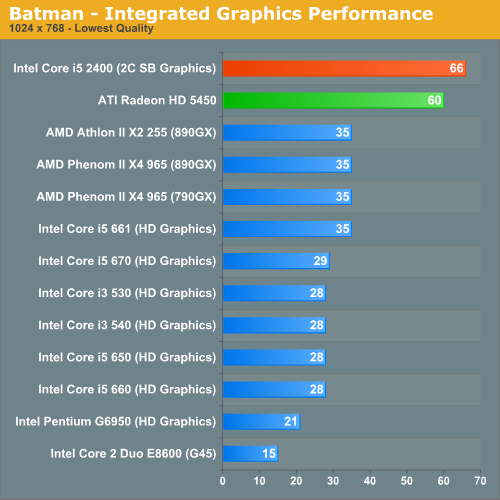
It's unclear whether or not graphics turbo was working on the part I was testing. If it was, this is the best it'll be for the 6 EU parts. If it wasn't, things will be even faster. Comparisons to current integrated graphics solutions are almost worthless. Sandy Bridge's graphics perform like a low end discrete part, not an integrated GPU. In this case, we're about 10% faster than a Radeon HD 5450.
Assuming Sandy Bridge retains the same HTPC features that Clarkdale has, I'm not sure there's a reason for these low end discrete GPUs anymore. At least not unless they get significantly faster.
Note that despite the early nature of the drivers, I didn't notice any rendering artifacts or image quality issues while testing Sandy Bridge's integrated graphics.
Dragon Age Origins
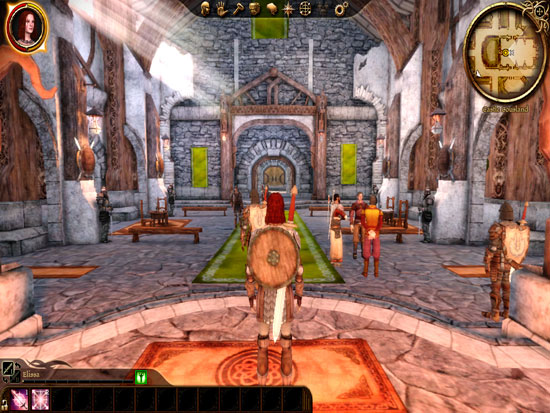
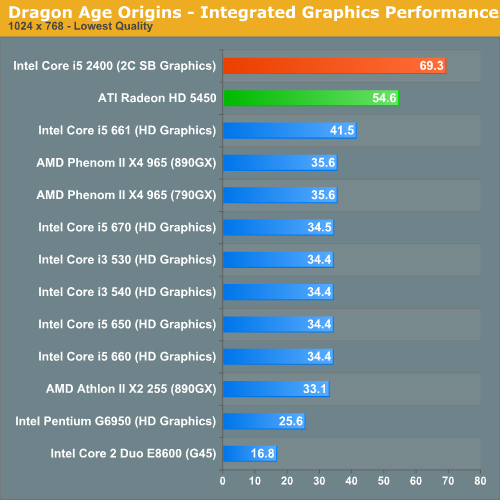
The Sandy Bridge advantage actually grows under Dragon Age. At these frame rates you can either enjoy smoother gameplay or actually up the resolution/quality settings to bring it back down to ~30 fps.
Dawn of War II
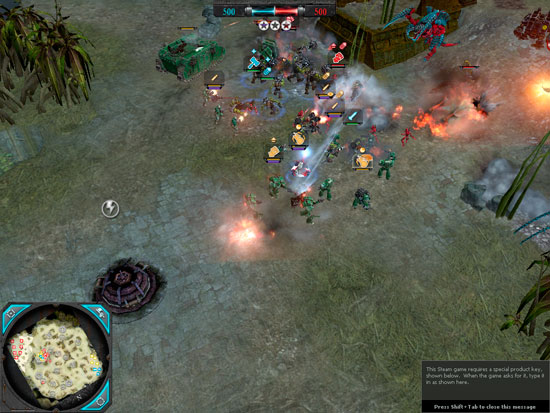
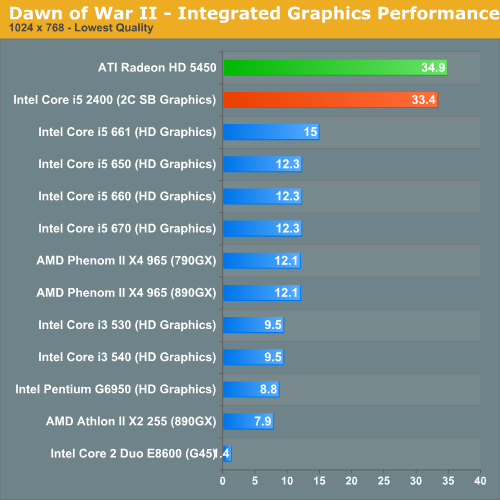
It's not always a clear victory for Sandy Bridge. In our Dawn of War II test the 5450 pulls ahead, although by only a small margin.
Call of Duty Modern Warfare 2
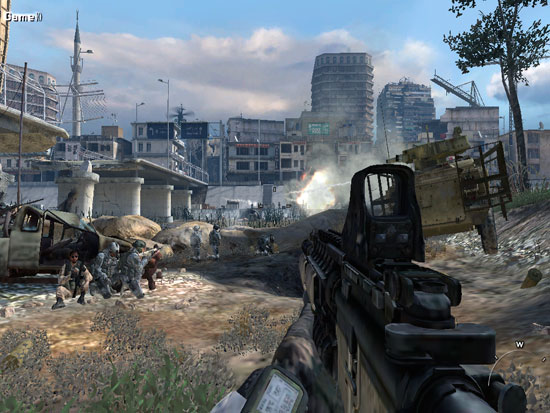
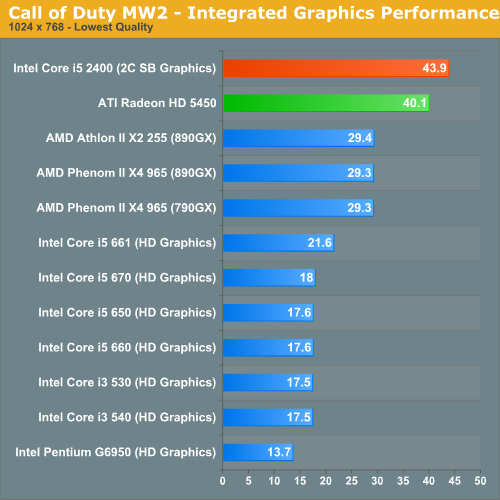
Sandy is one again on top of the 5450 in Modern Warfare 2. Although I'm not sure these frame rates are high enough to really up quality settings any more, they are at least smooth - which is more than I can say for the first gen HD Graphics.
BioShock 2
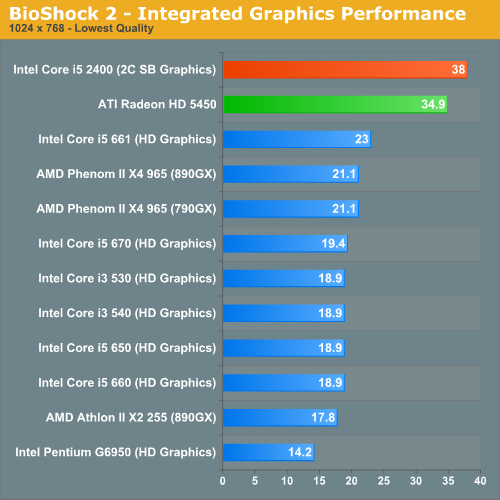
Intel promised to deliver a 2x improvement in integrated graphics performance with Sandy Bridge. We're getting a bit more than that here in BioShock 2.
World of Warcraft
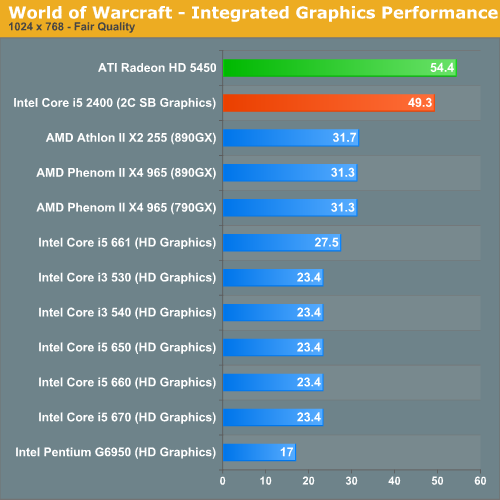
World of Warcraft is finally playable with Intel's Sandy Bridge graphics. The Radeon HD 5450 is 10% faster here.
HAWX
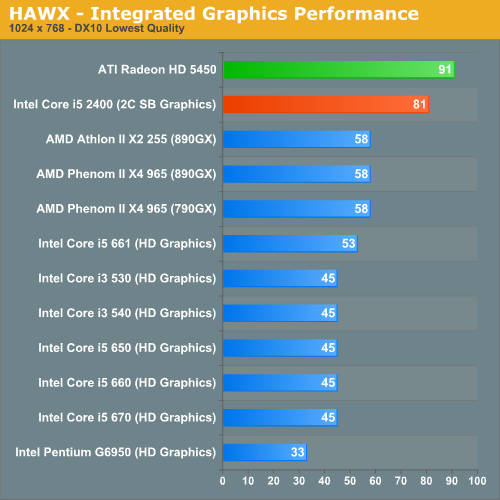
Sandy Bridge Graphics Performance Summary
This is still a very early look. Drivers and hardware both aren't final, but the initial results are very promising. Sandy Bridge puts all current integrated graphics solutions to shame, and even looks to nip at the heels of low end discrete GPUs. For HTPC users, Clarkdale did a good enough job - but for light gaming there wasn't enough horsepower under the hood. With Sandy Bridge you can actually play modern titles, albeit at low quality settings.
If this is the low end of what to expect, I'm not sure we'll need more than integrated graphics for non-gaming specific notebooks. Update: It looks like all notebook Sandy Bridge parts, at least initially, will use the 12 EU IGPs. Our SB sample may also have been a 12 EU part, we're still awaiting confirmation.










200 Comments
View All Comments
Anand Lal Shimpi - Friday, August 27, 2010 - link
You're correct, I didn't feel a dual vs. quad-core comparison was fair which is why I focused on the 760. I'll clear up the text though :)Take care,
Anand
Anand Lal Shimpi - Friday, August 27, 2010 - link
fixed :)mastrdrver - Friday, August 27, 2010 - link
If we go with what Anand has said and use the roadmap to guess pricing I just have one question then:Why in the world would anyone spend ~$300 for the 2500 and ~$500 on the 2600 then use the on chip gpu with no plans on some kind of discrete?
If the difference between a $600 HP is Llano and Sandy Bridge, Llano has a possibly huge advantage since I think its safe to assume that the gpu side will start at 5450 performance.
Its like Intel would be trying to tell you that SD Xbox 360 is better than HD Xbox 360 (Llano). Are you serious? If Llano can hit a pc at that price point and have a full shader count, Sandy Bridge is dead in the consumer market.
I know that's a lot of ifs and time between here and then but Intel doing what it has always done with graphics (suck) is going to haunt it. I think Intel let the door wide open and its head between it and the frame. All AMD has to do is shut it.
DanNeely - Friday, August 27, 2010 - link
There are people whose workloads are heavily CPU bound but who don't need a heavy duty GPU. Higher end servers and a lot of workstations fall into this category.Beyond that unless Intel made a GPUless die or deliberately disabled the onboard GPU there's no reason not to include it. While we'll have to wait until Intel shows off labeled die shots I doubt that the GPU is a large enough chunk to justify the engineering effort just to save a little on the manufacturing side.
mastrdrver - Saturday, August 28, 2010 - link
You are correct but my point was meant to be on "Best Buy" systems and not server or workstations. Sorry if I didn't get that clear.On the server front this will have to go up against Bulldozer which is an entirely different topic.
While it would be foolish for Intel to make a gpuless die since integration with the cpu side is inevitable, Larabee or what ever better be good. Then there is the driver thing. That Dragon Age Origin picture sure doesn't look right. For drivers that still have work to do, that picture looks exactly like the one from when Clarkdale was released. I'd be a little surprised if much driver work is left if those two pictures are actually different.
arh2o - Friday, August 27, 2010 - link
How much will these new 1155 motherboard prices be? Will they be in the same price range as the current 1156 motherboards?Rajinder Gill - Saturday, August 28, 2010 - link
I'd imagine the P67 boards will be priced between $150~$200.odin607 - Friday, August 27, 2010 - link
What about temps =(cmdrdredd - Friday, August 27, 2010 - link
I'm never buying an Intel CPU or Motherboard ever again. This is one area that made them what they are today. The ability to take a mid range part and clock it up is what made the Core 2 series such a success with gamers and other performance enthusiasts. Not all of the success is attributed to overclocking, but a good bit of the popularity came from a $200 CPU being able to clock up to levels that the $700+ cpus hit. Now, if the unlocked parts can hit big overclocks and aren't overpriced then maybe it'll work out. However, it's all to easy for Intel to give us the finger and price a $200 CPU at $600 because it's unlocked and say "tough crap, if you want to overclock then pay up!". I am hopeful it doesn't come to this.Anyway, quads are old news IMO...I'm looking at 6core for my next one.
JumpingJack - Saturday, August 28, 2010 - link
"but a good bit of the popularity came from a $200 CPU being able to clock up" ...Reading the preview, it looks like the 2500K may fit this description.
From the articles:
"...and the 2500K will replace the i5 760/655K ($205 - $216). ..."
Even the 875K, when it launched, wasn't as you claim... it actually came in 200 bucks cheaper than the 870.
http://techreport.com/articles.x/18988
It would seem to me that Intel has been planning this change for sometime and went out to address this....